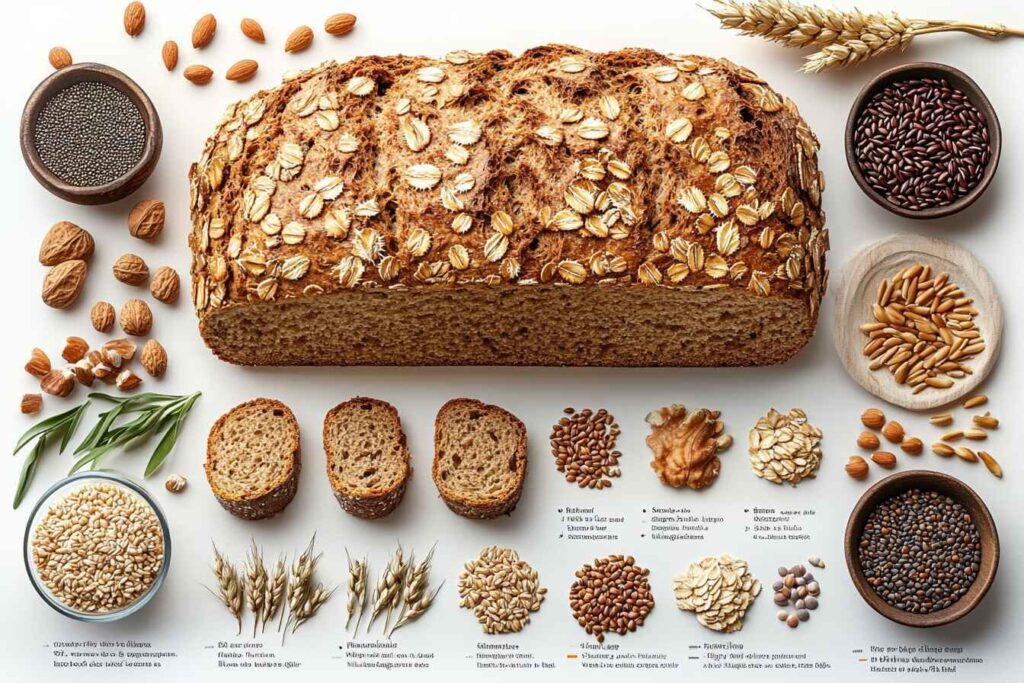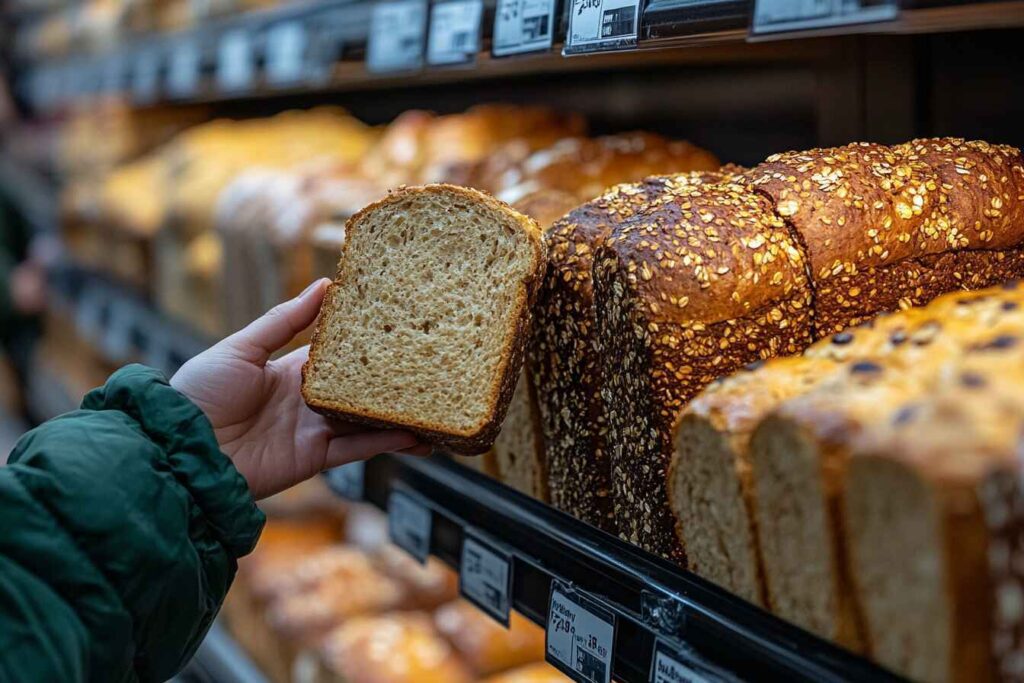Ever heard of wheatberry bread and wondered if it’s actually good for you? If you’re a bread lover trying to make healthier choices, you’re in the right place. Wheatberry bread is gaining popularity, but is it truly a nutritious option? Or is it just another trendy food hype? In this guide, we’ll dive deep into everything you need to know—from its nutritional benefits to who should (or shouldn’t) eat it!
What Is Wheatberry Bread?
Before we break down the health benefits, let’s talk about what wheatberry bread actually is. Unlike refined white bread, which is stripped of most of its nutrients, wheatberry bread is made from whole wheat berries—the entire grain! This means it includes the bran, germ, and endosperm, making it one of the most nutrient-dense bread options.
Did you know? Wheatberries are simply whole wheat kernels before they’re processed into flour. They retain all the fiber, protein, and vitamins found in whole grains!
Nutritional Profile of Wheatberry Bread
One of the main reasons wheatberry bread is considered healthy is because it packs a powerful punch of essential nutrients. Unlike regular store-bought bread, which is often loaded with preservatives and refined flour, wheatberry bread contains natural, wholesome ingredients that support overall health.

Key Ingredients in Wheatberry Bread
The ingredient list for wheatberry bread is refreshingly simple. A typical recipe includes:
| Ingredient | Function |
|---|---|
| Whole Wheat Berries | Main ingredient, high in fiber & nutrients |
| Whole Wheat Flour | Adds texture and structure |
| Yeast | Leavening agent, helps bread rise |
| Water | Essential for dough formation |
| Salt | Enhances flavor |
| Honey (Optional) | Natural sweetener |
Macronutrients: Carbs, Protein, and Fats
Wheatberry bread is primarily a source of complex carbohydrates, which provide slow-releasing energy. Unlike white bread, which causes blood sugar spikes, the high fiber content in wheatberry bread helps maintain steady energy levels.
| Nutrient | Per 1 Slice (Approx. 50g) |
|---|---|
| Calories | 120 |
| Carbohydrates | 22g |
| Fiber | 4g |
| Protein | 5g |
| Fat | 1g |
| Sugar | 1g |
As you can see, wheatberry bread is a low-fat, high-fiber bread that keeps you feeling full longer—perfect if you’re trying to eat healthier!
Vitamins and Minerals in Wheatberry Bread
Whole wheatberries retain all the essential vitamins and minerals that are often lost in refined flour. A slice of wheatberry bread provides:
- B Vitamins – Supports energy production and brain function
- Iron – Helps with oxygen transport in the blood
- Magnesium – Crucial for muscle and nerve function
- Zinc – Supports immunity and healing
Tip: Want to boost the nutritional value? Try wheatberry bread with nut butter or avocado for added healthy fats and protein!
Health Benefits of Wheatberry Bread
So, what makes wheatberry bread so much better than regular bread? Let’s go over the key benefits.
1. High in Fiber for Digestion and Gut Health
If you’ve ever dealt with bloating, constipation, or digestive issues, fiber is your best friend. Wheatberry bread is packed with dietary fiber, which promotes healthy digestion and keeps things moving smoothly.
Fun Fact: The fiber in wheatberry bread acts like a broom, sweeping out toxins and keeping your gut healthy!
2. Supports Heart Health and Lowers Cholesterol
Eating whole grains like wheatberry bread has been linked to a reduced risk of heart disease. The fiber helps lower bad cholesterol (LDL) while promoting good cholesterol (HDL), keeping your heart in top shape.
3. A Good Source of Plant-Based Protein
While bread isn’t usually associated with protein, wheatberry bread actually provides a decent amount—around 5g per slice. If you’re vegetarian or simply trying to add more plant-based protein to your diet, this bread is a great option.
4. Helps with Weight Management
Struggling to lose weight? One of the biggest reasons people overeat is because they don’t feel full after meals. Thanks to its high fiber and protein content, wheatberry bread helps curb hunger, preventing unnecessary snacking.
5. Provides Long-Lasting Energy
Unlike refined carbs that give you a quick sugar rush (followed by an energy crash), wheatberry bread provides slow-releasing energy. This makes it an excellent choice for breakfast or pre-workout meals.
Best time to eat it? Morning or lunch! It keeps you energized throughout the day without feeling sluggish.
Common Concerns About Wheatberry Bread
While wheatberry bread has many benefits, it’s not for everyone. Here are some common concerns people have:
- Is it high in calories? Not really! It has a moderate calorie count, but it’s packed with nutrients.
- Is it suitable for a low-carb diet? Not exactly. It’s a whole grain, so it still contains carbs.
- Does it contain gluten? Yes, which means it’s not suitable for people with celiac disease.
Want a gluten-free alternative? Try bread made with quinoa, almond flour, or buckwheat!
Who Should Eat Wheatberry Bread?
Now that we’ve covered the amazing health benefits of wheatberry bread, let’s talk about who can benefit the most from including it in their diet. While it’s a great option for many people, some groups will find it particularly beneficial.
1. Best for Active Individuals and Athletes
If you’re always on the move, whether it’s hitting the gym, running, or engaging in sports, wheatberry bread can be a fantastic addition to your meals. Why? Because it provides long-lasting energy, thanks to its complex carbohydrates.
Tip: Pair a slice of wheatberry bread with peanut butter or eggs for a high-protein, energy-boosting meal.
2. Suitable for Diabetics?
People with diabetes often need to be careful with their carb intake. The good news is that wheatberry bread has a **lower glycemic index (GI)** compared to white bread, meaning it won’t spike blood sugar levels as quickly. However, moderation is key!
3. Can It Fit into a Weight Loss Diet?
Absolutely! Many people assume that all bread is bad for weight loss, but that’s not true. Since wheatberry bread is high in fiber and protein, it helps keep you full longer, reducing cravings and unnecessary snacking.
Weight loss hack: Toast a slice of wheatberry bread, top it with avocado and poached eggs for a filling, nutrient-dense breakfast.
Who Should Avoid Wheatberry Bread?
As much as wheatberry bread is a nutritional powerhouse, it’s not for everyone. Here are a few groups of people who might want to steer clear.
1. People with Celiac Disease or Gluten Sensitivity
Since wheatberry bread is made from whole wheat, it contains gluten. For people with celiac disease or gluten intolerance, consuming it can lead to digestive discomfort, bloating, or more serious health issues.
2. Those Following a Strict Low-Carb or Keto Diet
If you’re on a ketogenic or very low-carb diet, wheatberry bread won’t fit into your meal plan. While it’s a healthier carb option, it still contains carbohydrates, which keto followers try to avoid.
3. People with Wheat Allergies
Some individuals have allergies to wheat, which can cause reactions ranging from mild bloating to severe digestive distress. If you have a wheat allergy, it’s best to opt for alternative breads made from **quinoa, almond flour, or coconut flour.**
How to Make Wheatberry Bread at Home
Want to try baking your own fresh, homemade wheatberry bread? It’s easier than you think! Plus, making it at home lets you control the ingredients, ensuring you get the healthiest version possible.
Ingredients Needed
| Ingredient | Quantity |
|---|---|
| Whole wheat berries | 1 cup |
| Whole wheat flour | 3 cups |
| Warm water | 1 cup |
| Yeast | 2 1/4 tsp (1 packet) |
| Honey or maple syrup | 2 tbsp |
| Salt | 1 1/2 tsp |
| Olive oil | 2 tbsp |
Step-by-Step Recipe
- Prepare the wheatberries: Soak the wheatberries in water overnight, then drain and cook them in fresh water for about 30 minutes until soft.
- Activate the yeast: In a small bowl, mix warm water, honey, and yeast. Let it sit for 5-10 minutes until it becomes foamy.
- Mix the dough: In a large mixing bowl, combine whole wheat flour, cooked wheatberries, salt, and olive oil. Add the yeast mixture and stir until it forms a dough.
- Knead the dough: Turn the dough onto a floured surface and knead for about 8-10 minutes until smooth and elastic.
- First rise: Place the dough in a greased bowl, cover with a towel, and let it rise for 1 hour or until doubled in size.
- Shape and second rise: Punch down the dough, shape it into a loaf, and place it in a greased loaf pan. Cover and let it rise for another 30 minutes.
- Bake: Preheat the oven to 375°F (190°C). Bake for 30-35 minutes until golden brown.
- Cool and enjoy: Remove from the oven and let the bread cool before slicing.
Pro Tip: Store homemade wheatberry bread in an airtight container to keep it fresh for up to a week.
Best Ways to Eat Wheatberry Bread
Not sure how to enjoy wheatberry bread? Here are some tasty and nutritious ideas!
1. Pairing Wheatberry Bread with Healthy Spreads
- Avocado & Egg: A heart-healthy combo packed with protein and healthy fats.
- Almond Butter & Banana: A perfect pre-workout snack that fuels your body.
- Cream Cheese & Smoked Salmon: A savory, protein-rich option.
2. Creative Sandwich Ideas
Wheatberry bread is perfect for hearty sandwiches. Try these ideas:
- Grilled Turkey & Cheese: A warm, melty delight.
- Veggie & Hummus: A light yet satisfying lunch option.
- Chicken Salad with Cranberries: A flavorful, high-protein sandwich.
3. Using Wheatberry Bread in Breakfast Recipes
Start your day the right way with these ideas:
- French Toast: Swap regular bread for wheatberry bread for a fiber boost.
- Avocado Toast with Poached Eggs: The ultimate healthy breakfast.
- Toasted with Butter & Honey: A simple but delicious option.
Experiment: Try toasting your wheatberry bread and adding cinnamon and Greek yogurt for a sweet, protein-packed snack!
Buying Guide: How to Choose the Best Whole-Grain Bread
Not everyone has the time to bake fresh bread at home. But that doesn’t mean you have to settle for store-bought options that are filled with additives. Knowing how to pick a high-quality loaf makes all the difference!

1. Read the Nutrition Label Carefully
All breads are not created equal! Some brands sneak in refined flour, preservatives, or extra sugar, making them less nutritious. Always check the label to ensure you’re getting a wholesome product.
| Good Ingredients | Avoid These |
|---|---|
| Whole wheat berries | Enriched wheat flour |
| Whole wheat flour | High fructose corn syrup |
| Natural yeast | Artificial preservatives |
| Seeds (flax, sunflower, etc.) | Hydrogenated oils |
Pro Tip: If the first ingredient isn’t “whole wheat” or “wheatberries,” put that loaf back on the shelf!
2. Watch Out for Hidden Sugars
You’d be surprised how many brands add sugar to make their products taste better. Look for options that contain **less than 3g of sugar per slice**.
3. Spot Artificial Ingredients and Additives
A truly healthy loaf should have **a short and simple ingredient list**. If you see long chemical names or artificial additives, it’s best to look for another option.
4. Where to Buy Quality Whole-Grain Bread
Want the best of the best? Here are some great places to shop:
- Local bakeries: Many artisanal bakeries offer preservative-free, fresh loaves.
- Health food stores: Organic, whole-grain varieties are often available at Whole Foods, Trader Joe’s, and similar stores.
- Farmers’ markets: A fantastic place to find locally made, high-quality bread.
- Online retailers: Some specialty brands offer delivery for fresh, healthy options.
Bonus Tip: If buying in bulk, freeze extra loaves to maintain freshness!
Expert Opinions and Scientific Studies on Whole-Grain Bread
Still unsure if this type of bread is worth adding to your diet? Let’s take a look at what nutritionists and researchers have to say.
1. Research on Whole Grains and Their Health Benefits
Studies published in the American Journal of Clinical Nutrition have linked whole grains to:
- Reduced risk of heart disease: Fiber-rich grains help lower LDL cholesterol.
- Improved digestion: High fiber content promotes gut health.
- Better weight management: Whole grains support appetite control.
- Lower risk of Type 2 diabetes: Their lower glycemic impact helps regulate blood sugar.
2. What Nutritionists Say About Whole-Grain Bread
Dr. Emily Carter, Registered Dietitian: “Choosing bread made from whole grains is a great way to increase fiber intake, improve digestion, and support long-term health.”
Mark Reynolds, Certified Nutrition Coach: “If you want sustained energy without blood sugar crashes, whole-grain bread is an excellent addition to your diet.”
Conclusion: Should You Include Whole-Grain Bread in Your Diet?
So, is this type of bread worth eating? Absolutely! Packed with fiber, protein, and essential nutrients, it’s a great alternative to refined white bread. Plus, it offers plenty of health benefits, from improved digestion to better heart health.
However, it’s not ideal for everyone, especially those with gluten sensitivity or those on a strict low-carb diet. But for most people, switching to whole-grain bread is a smart move for a healthier lifestyle.
Final Thought: Want a healthier diet? Ditch white bread and switch to a fiber-rich alternative for lasting benefits!
FAQs About Whole-Grain Bread
1. Is This Bread Healthier Than Regular Whole Wheat Bread?
Yes! While both are made from whole wheat, bread made from unprocessed grains retains more fiber and nutrients, making it a better choice.
2. Can You Eat This Bread Every Day?
Absolutely! If you’re eating a balanced diet, you can enjoy it daily—just be mindful of portion sizes, especially if you’re monitoring carbs.
3. How Does It Affect Blood Sugar Levels?
Unlike refined bread, which causes quick blood sugar spikes, this one has a **lower glycemic index**, providing slow-releasing energy.
4. How Can You Store Whole-Grain Bread?
Store it in an airtight container at **room temperature for up to 5 days**. For longer storage, wrap and freeze it for up to 3 months.
5. Is It Vegan?
Most whole-grain breads are naturally vegan, but some contain **honey, milk, or butter**. Always check the ingredient list if you’re following a plant-based diet.
6. What Can You Eat with It?
Try these delicious pairings:
- Hummus & roasted vegetables – A great plant-based meal.
- Greek yogurt & berries – A high-protein, antioxidant-rich breakfast.
- Turkey & avocado – A protein-packed sandwich option.
Final Tip: Experiment with different toppings to keep your meals exciting and nutritious!

